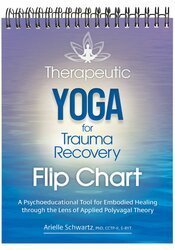How to Incorporate the Power of Therapeutic Yoga for Trauma Recovery

Therapeutic yoga bridges a path of healing between the psyche and the body. This specialized approach to yoga focuses on using yoga practices to support physical, mental, and emotional healing. It combines the principles and techniques of traditional yoga with a more individualized and therapeutic approach, often tailored to specific health concerns or conditions.
The primary goal of therapeutic yoga is to promote overall well-being and aid in the management of various health issues, such as chronic pain, stress, anxiety, depression, injuries, and certain medical conditions. This is achieved by adapting yoga postures (asanas), breathing exercises (pranayama), meditation techniques, and relaxation methods to meet the specific needs and limitations of individuals.
Dr. Arielle Schwartz, author of the newly released , shares insights on how to incorporate the principles of polyvagal theory, affective neuroscience, and trauma-informed care into your therapy office.
There were so many positive outcomes and I wanted to understand more of this. By the time I was 23, I had completed my yoga teacher training at Kripalu. I was teaching wherever I could. Then, I started teaching in wilderness therapy. I was working with Youth at Risk and we would just sit down next to the trail and I would teach them yoga.
It was after thatŌĆöwhen I moved to BoulderŌĆöthat I taught at the University of Colorado in what we called the fishbowl, which was this little yoga space that was the wrestling room underneath the skating rink with a little water dripping down on us. But again and again, the feedback I received and the experience in my own body was invaluable.
So, I really devoted so much of my life to integrating this into my overall work with individuals who've experienced trauma.
When I moved to Boulder, Colorado, I was tending a master's degree in somatic psychology. The program that I was working in was integrating all this neuroscience into our understanding of the neuroscience of the body, mind connection and the vagus nerve kept kind of coming back into the conversation again and again. In 2010, I was introduced to polyvagal theory, and in 2012, I began to study with Dr. Stephen Porges.
Once I started to understand how the vagus nerve is the wandering nerve, and it connects the gut, the heart, our lungs, the throat, and the muscles of the face to our brain stemŌĆöand all of that connection and communication network helps our brain do a better job regulating things like our digestion, our respiratory rate, our heart rate, and our stress response to the world, plus our ability to recover from stressŌĆöit felt like just one light bulb went off after another. And I knew that this was a big part of why yoga leads to such vast positive outcomes that I was seeing in my classes and that I was experiencing in myself.
And on the back of the pages are the descriptions, so that if you still are kind of new to polyvagal theory and you need to know how to explain this to your clients, it gives you that tool too.
I have made it kind of my professional life's mission to bridge that gap to help create very simple tools that help therapists know the how, because most of them know the why now and really see the benefits and they're just going, ŌĆ£Well, what's the next step?ŌĆØ
When you go through the flip chart, it gives you those same practices that are in the book, but itŌĆÖs just the practice with the script and it really guides the clinician to go, ŌĆ£We just need to do this one thing. This will be beneficial for today.ŌĆØ
And once we know the baseline of the nervous system state, we can then adapt the practice and find those key practices that help bring the nervous system into more alertness or more ease.
The primary goal of therapeutic yoga is to promote overall well-being and aid in the management of various health issues, such as chronic pain, stress, anxiety, depression, injuries, and certain medical conditions. This is achieved by adapting yoga postures (asanas), breathing exercises (pranayama), meditation techniques, and relaxation methods to meet the specific needs and limitations of individuals.
Dr. Arielle Schwartz, author of the newly released , shares insights on how to incorporate the principles of polyvagal theory, affective neuroscience, and trauma-informed care into your therapy office.
Therapeutic Yoga for Trauma Recovery
How did you develop an interest in therapeutic yoga for trauma?
It was rooted in my own childhood wounds, and it was manifesting in that way. I had been introduced to yoga as a young child, and then I walked away from it as a teenager, and I returned to it again in college. When I would go to yoga, I would feel this calm and this ease or this feeling of coming home to myselfŌĆöthe feeling that my mind had settled back down, that my body felt more regulated, I could sleep better, and my digestion was better.There were so many positive outcomes and I wanted to understand more of this. By the time I was 23, I had completed my yoga teacher training at Kripalu. I was teaching wherever I could. Then, I started teaching in wilderness therapy. I was working with Youth at Risk and we would just sit down next to the trail and I would teach them yoga.
It was after thatŌĆöwhen I moved to BoulderŌĆöthat I taught at the University of Colorado in what we called the fishbowl, which was this little yoga space that was the wrestling room underneath the skating rink with a little water dripping down on us. But again and again, the feedback I received and the experience in my own body was invaluable.
So, I really devoted so much of my life to integrating this into my overall work with individuals who've experienced trauma.
Why is applied polyvagal theory a central part of this model?
Part of the process for me was as I got to know the impact that this was having for me personally for others and looking at the research about yoga used therapeutically. Then there was this other question of why? Why does this work? What is really what is really going on here? And it was also around that same time in my life, in my early twenties, that I decided to study somatic psychology in part to answer that question of why.When I moved to Boulder, Colorado, I was tending a master's degree in somatic psychology. The program that I was working in was integrating all this neuroscience into our understanding of the neuroscience of the body, mind connection and the vagus nerve kept kind of coming back into the conversation again and again. In 2010, I was introduced to polyvagal theory, and in 2012, I began to study with Dr. Stephen Porges.
Once I started to understand how the vagus nerve is the wandering nerve, and it connects the gut, the heart, our lungs, the throat, and the muscles of the face to our brain stemŌĆöand all of that connection and communication network helps our brain do a better job regulating things like our digestion, our respiratory rate, our heart rate, and our stress response to the world, plus our ability to recover from stressŌĆöit felt like just one light bulb went off after another. And I knew that this was a big part of why yoga leads to such vast positive outcomes that I was seeing in my classes and that I was experiencing in myself.
WhatŌĆÖs your vision for how this flip chart might be used in the therapy office?
When I was talking with you about this idea of creating a flip chart, it was basically to create ease in how psychotherapists can bring practices into their sessions, how to do it quickly and usefully, and to be able to explain what polyvagal theory is to their clients using simple, accessible images.And on the back of the pages are the descriptions, so that if you still are kind of new to polyvagal theory and you need to know how to explain this to your clients, it gives you that tool too.
I have made it kind of my professional life's mission to bridge that gap to help create very simple tools that help therapists know the how, because most of them know the why now and really see the benefits and they're just going, ŌĆ£Well, what's the next step?ŌĆØ
When you go through the flip chart, it gives you those same practices that are in the book, but itŌĆÖs just the practice with the script and it really guides the clinician to go, ŌĆ£We just need to do this one thing. This will be beneficial for today.ŌĆØ
And once we know the baseline of the nervous system state, we can then adapt the practice and find those key practices that help bring the nervous system into more alertness or more ease.
Therapeutic Yoga for Trauma Recovery Flip Chart

In the Therapeutic Yoga for Trauma Recovery Flip Chart, licensed psychologist, registered yoga teacher, and renowned trauma expert Dr. Arielle Schwartz provides a variety of foundational yoga, breathing, and meditative practices to balance, energize, and calm the body. Grounded within the principles of polyvagal theory, affective neuroscience, and trauma-informed care, this flip chart will help clients understand the impact of traumatic stress on the brain and body while deepening awareness of the body's vagal state.
Meet the Expert:
Arielle Schwartz, PhD, CCTP-II, E-RYT, is a clinical psychologist, internationally sought-out teacher, therapeutic yoga instructor, and leading voice in the healing of PTSD and complex trauma. She is the author of six books based upon her integrative, mind-body approach to trauma recovery: The Complex PTSD Workbook; The Post Traumatic Growth Guidebook; A Practical Guide to Complex PTSD; EMDR Therapy and Somatic Psychology; The Complex PTSD Treatment Manual, and Therapeutic Yoga for Trauma Recovery. Her unique blend of spirituality and science can be found in her writings, guided trauma recovery programs, and applied Polyvagal Theory in yoga for trauma recovery.
Learn more about his educational products, including upcoming live seminars, by clicking here.
Learn more about his educational products, including upcoming live seminars, by clicking here.



